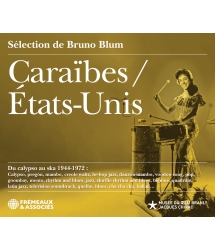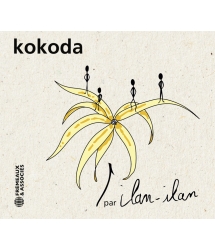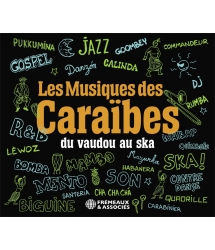- Our Catalog
- Philosophy
- Philosophers of the 20th century and today
- History of Philosophy (PUF)
- Counter-History and Brief Encyclopedia by Michel Onfray
- The philosophical work explained by Luc Ferry
- Ancient thought
- Thinkers of yesterday as seen by the philosophers of today
- Historical philosophical texts interpreted by great actors
- History
- Books (in French)
- Social science
- Historical words
- Audiobooks & Literature
- Our Catalog
- Jazz
- Blues
- Rock - Country - Cajun
- French song
- World music
- Africa
- France
- Québec / Canada
- Hawaï
- West Indies
- Caribbean
- Cuba & Afro-cubain
- Mexico
- South America
- Tango
- Brazil
- Tzigane / Gypsy
- Fado / Portugal
- Flamenco / Spain
- Yiddish / Israel
- China
- Tibet / Nepal
- Asia
- Indian Ocean / Madagascar
- Japan
- Indonesia
- Oceania
- India
- Bangladesh
- USSR / Communist songs
- World music / Miscellaneous
- Classical music
- Composers - Movie Soundtracks
- Sounds of nature
- Our Catalog
- Youth
- Philosophy
- News
- How to order ?
- Receive the catalog
- Manifesto
- Dictionnary











- Our Catalog
- Philosophy
- Philosophers of the 20th century and today
- History of Philosophy (PUF)
- Counter-History and Brief Encyclopedia by Michel Onfray
- The philosophical work explained by Luc Ferry
- Ancient thought
- Thinkers of yesterday as seen by the philosophers of today
- Historical philosophical texts interpreted by great actors
- History
- Books (in French)
- Social science
- Historical words
- Audiobooks & Literature
- Our Catalog
- Jazz
- Blues
- Rock - Country - Cajun
- French song
- World music
- Africa
- France
- Québec / Canada
- Hawaï
- West Indies
- Caribbean
- Cuba & Afro-cubain
- Mexico
- South America
- Tango
- Brazil
- Tzigane / Gypsy
- Fado / Portugal
- Flamenco / Spain
- Yiddish / Israel
- China
- Tibet / Nepal
- Asia
- Indian Ocean / Madagascar
- Japan
- Indonesia
- Oceania
- India
- Bangladesh
- USSR / Communist songs
- World music / Miscellaneous
- Classical music
- Composers - Movie Soundtracks
- Sounds of nature
- Our Catalog
- Youth
- Philosophy
- News
- How to order ?
- Receive the catalog
- Manifesto
- Dictionnary
CORTIJO • ISMAEL RIVERA • EDDIE PALMIERI • CUARTETO PUERTO RICO
VARIOUS ARTISTS
Ref.: FA5815
EAN : 3561302581521
Artistic Direction : BRUNO BLUM
Label : Frémeaux & Associés
Total duration of the pack : 2 hours 11 minutes
Nbre. CD : 2
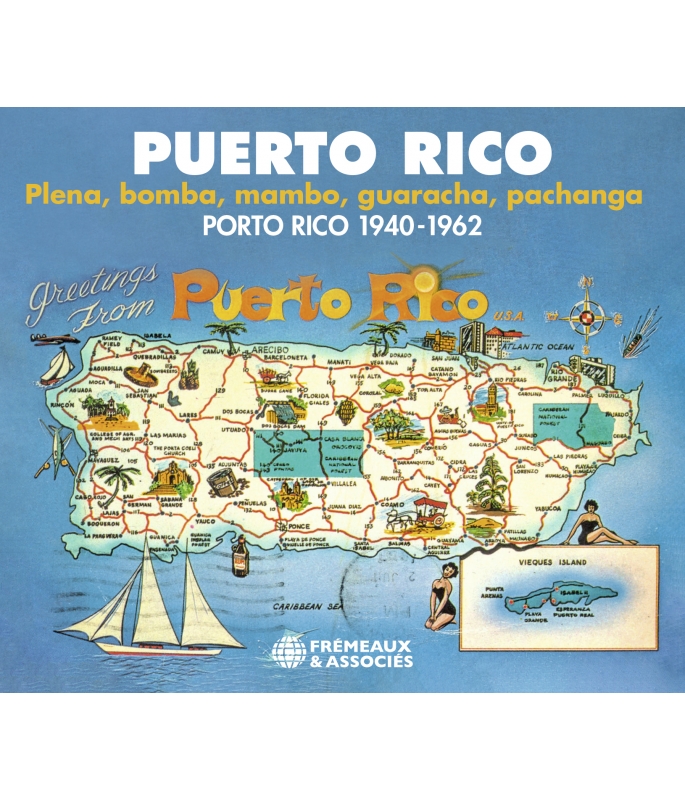
CORTIJO • ISMAEL RIVERA • EDDIE PALMIERI • CUARTETO PUERTO RICO
- -
- -
CORTIJO • ISMAEL RIVERA • EDDIE PALMIERI • CUARTETO PUERTO RICO
This is Puerto Rico’s genuine music before salsa came. Born in the 1960s, salsa (“sauce”) is a mix of Puerto Rican, Dominican and Cuban music — with a Puerto Rican sauce. But way before the days of Fania All Stars, Latin America was dancing to even more powerful sounds: the founding bomba, plena and pachanga. Bruno Blum comments this historical insight into the most essential Puerto Rican sounds, featuring giants like Ismael Rivera, Cortijo, Chiquitín Garcia and Eddie Palmieri. From San Juan’s working-class area and all the way to the dancefloors, this is dance music par excellence.
Patrick FRÉMEAUX
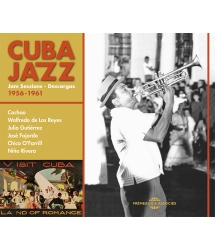
JAM SESSIONS - DESCARGAS 1956-1961
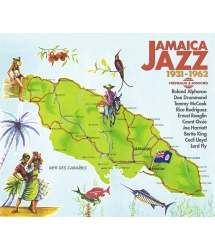
ROLAND ALPHONSO • DON DRUMMOND • TOMMY McCOOK • RICO...
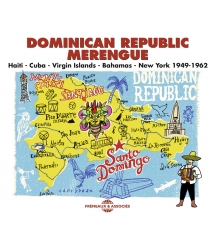
HAITI - CUBA - VIRGIN ISLANDS - BAHAMAS - NEW YORK...
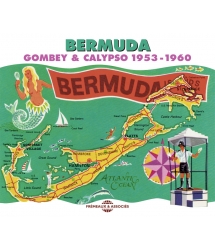
GOMBEY & CALYPSO 1953-1960




-
PisteTitleMain artistAutorDurationRegistered in
-
1Permita DiosBobby CapoBobby Capo00:03:041940
-
2Mambo AwayHumberto MoralesGloria Parker00:02:471951
-
3110Th Street And 5Th AvenueNoro MoralesNorosbaldo Morales00:02:481951
-
4El CharlatanOrquesta PanamericanaTonin Romero00:02:521951
-
5Mambo MonoNoro MoralesNorosbaldo Morales00:02:541951
-
6El Pilon de TomasaCortijo y su ComboRay Santos00:02:511954
-
7MicaelaCortijo y su ComboRafael Cepeda00:02:491954
-
83D MamboCesar ConcepcionRay Santos00:03:001954
-
9Juan JoseCortijo y su ComboRafael Cepeda00:02:571956
-
10Conoci a Tu PapaCortijo y su ComboVelez Rogelio00:02:551955
-
11ChongoloCortijo y su ComboMeguelito Miranda00:02:451955
-
12El Bombon de ElenaCortijo y su ComboRafael Cepeda00:03:171955
-
13Mazurka MariaCuarteto Puerto RicoInconnu00:02:541955
-
14Aguinaldo HibaroCuarteto Puerto RicoInconnu00:04:301955
-
15El Dia 3 de SeptiembreRoberto CasillasInconnu00:03:251955
-
16De Las Montanas VenimosCuarteto Puerto RicoInconnu00:02:431954
-
17Aguinaldo CaguenoCuarteto Puerto RicoInconnu00:04:241954
-
18El Disco de CartonChiquitin Garcia y su TrioChiquitin00:02:501956
-
19Caballero Que BombaCortijo y su ComboRafael Ortiz00:03:021957
-
20Calypso Bomba y PlenaCortijo y su ComboKito Velez00:02:481957
-
21El ChivoCortijo y su ComboVirgilio Gonzales00:03:011959
-
22El TrompoCortijo y su ComboHector Santos00:02:471959
-
PisteTitleMain artistAutorDurationRegistered in
-
1Me Voy a DivorciarChiquitin Garcia y su TrioChiquitin00:02:531958
-
2Ay LolaChiquitin Garcia y su TrioDe Jesus00:02:551958
-
3EnsillalaCortijo y su ComboRafael Ithier00:03:061959
-
4Plena EspanolaCortijo y su ComboJuancin Ramirez00:02:571959
-
5Bomba CarabombaCortijo y su ComboAlberto Amadeo00:02:421959
-
6Caramelo SantoCortijo y su ComboMarguerita Rivera00:02:411959
-
7Maria TeresaCortijo y su ComboJuan Verdejo00:02:441959
-
8TuntunecoCortijo y su ComboSarah Rodriguez00:02:411960
-
9Pa Tumbar La CanaCortijo y su ComboKito Velez00:02:431960
-
10Yo Soy del CampoCortijo y su ComboRafael Cortijo00:02:191960
-
11Que Feo El PichonCortijo y su ComboRafael Ithier00:02:591960
-
12Lo Tuyo Es CronicoCortijo y su ComboChiquitin00:02:521960
-
13OlvidaloTorruellas y su ComboAngel Luis Torruellas00:02:581960
-
14OrizaCortijo y su ComboSilvestre Mendez00:02:321962
-
15Druma CuyiCortijo y su ComboSilvestre Mendez00:03:151962
-
16Pa Fricase Los PollosLou Perez y su CharangaLou Perez00:02:401962
-
17En OrbitaBaltazar CarreroBaltazar Carrero00:02:541961
-
18ConmigoEddie Palmieri y su Conjunto La PerfectaEddie Palmieri00:02:451962
-
19La GiocondaEddie Palmieri y su Conjunto La PerfectaJuan Quevedo00:03:181962
-
20Karakatis-KiMon Rivera y su OrquestaMon Rivera00:03:021962
-
21PachangueandoLou Perez y su CharangaLou Perez00:04:011962
-
22La Pachanga se Baila AsiJoe Quijano y su OrquestaCharlie Palmieri00:03:051962
Puerto Rico
Plena, Bomba, Mambo, Guaracha, Pachanga
1940-1962
By Bruno Blum
LATIN NORTH AMERICA
Arawak-speaking Taino Native Americans called their island Borinquen, “The Land of the Great Lords”. They are also called the Borinquen, as well as Jíbaros or Híbaros, as sung here by the Cuarteto Puerto Rico in Aguinaldo Híbaro. “Híbaro” is Spanish for indigenous South Americans. Baltazar Carrero (1917-2008) was a Jíbaro and his En Órbita, complete with guitar and accordion, is a typical plena.
In 1898, The United States took Puerto Rico and Cuba from the Spaniards. They purchased the Western part of the nearby Virgin Islands next1 (Culebra and Vieques were already part of the Puerto Rican territory). The presence of the guitar owes much to this Spanish past (check out Roberto Casillas and Chiquitín Garcia)2.The same goes for analogous instruments such as the tres (Cuarteto Puerto Rico) and the cuatro on Olvídalo. Other European influences left their mark on Puerto Rico, such as the Nineteenth Century Polish mazurka trend.
SANTERÍA
Local Christian religions — mainly the Catholic — have produced spiritual songs. As in Cuba and the Dominican Republic, melodies and intonations of Hispanic songs left their mark on local music.
However, it is the musical expression of Afro-Puerto Ricans that increasingly dominated the island’s music and its diasporas, since at least the 1940s.
The descendents of Africans have kept traditions such as palo mayombe (Bantu spirituality) and santería (Yoruba spirituality), both of which are much alike Cuba’s. By 1962 Cortijo issued trance music derived from these, including the excellent Druma Cuyi. In presenting this hypnotic piece as an “oriza rhythm” (rhythm of the spirits) he openly claimed Africa’s legacy, free dancing and implicitly expressed his respect for dark skin, which was much deprecated at the time. Trance, and possession by a spirit, were the next logical step.
This is the also the case on Oriza, which was composed with Cuban musician Silvestre Méndez. In this tune, singer Ismael Rivera alludes to Orishas (Yoruba deities) on a “ganga” rhythm (one of bomba’s rhythms). Afro-Puerto Rican music by top stars like Cortijo y su Combo has contributed in freeing the population from the “Black complex”. They openly sang of their deep feelings, backed by these polyrhythmic allusions to Santería3.
The proximity and presence of trance runs through many Puerto Rican recordings of the time, such as a more trivial Pa Fricase Los Pollos by Lou Perez and his Charanga Orchestra, or again in (New Yorker of Puerto Rican origin) Eddie Palmieri’s syncopated pachanga Conmigo.
In spite of the deprecation of Afro-Puerto Rican cultures, valorisation of Black culture was not consistent in Puerto Rican music as it was in the USA or Cuba. But it really asserted itself with the 1955-1962 records that made Cortijo y su Combo and their singer, Ismael Rivera, the Number One stars in Puerto Rico.
Bomba
Puerto Rican bomba was documented as early as 1797. It enabled captives from different African cultures to communicate and slaves used it to set up various uprisings. It was reputedly born in Mayagüez, in the far west of the island, However, a dance rhythm bearing the same name was also found in Haitian voodoo4.
Bomba spread out and has since become an emblem of Afro-Puerto Rican culture. There are several different practices in existence (the main drum is or isn’t played horizontally, it’s bigger in Ponce than elsewhere, etc.). It is similar to Guadeloupean gwoka, to Colombian cumbia’s bullerengue and Jamaican maroon drumming.
Bomba was played on three drums made of goatskin and rum barrels called barriles or bombas; the rhythm was kept on the buleador while another smaller drum, the primo or subidor, played by the tocador, followed the dancer’s movements, which are called “piquetes”.
The music is a sonorous extension of these movements. A dialogue between motion and drum was thus improvised. White suits and hats were assumed and worn by the dancers; the female dancers wore petticoats under their skirts and their moves produced a unique type of dance — the Bomba. The cuás (a type of clave stick) was originally hit on the wood of the barrel and this percussion style is attributed to an indigenous legacy. A big maraca played by the singer completed the rhythm.
There are three basic rhythms. First is the slow yuba, which evokes the bravery and sadness of the San Juan capital area.
Then there is the holandé, which is typical of the Santurce neighbourhood of San Juan and Cataño) and the sica, which means “walk”.
Each is offered in a range of local variations. The sicá exists as the belén santurce, an inspiration typical of Santurce, which might be derived from the Martinique bel-air aka bélè (belén [crèche, mess] and was played during joyous wakes on the island).
The calendá variation took its name from the traditional dance of the French Caribbean, itself derived from the martial arts of the Congo (stick fighting has become the national sport of Trinidad5) and is similar to Brazilian capoeira.
Calinda was also sung about in songs from Louisiana and, once again, we note the presence of the Bámbula, a popular dance in the Afro-Caribbean world of the nineteenth century. Its name is found in Haitian voodoo rituals, as well as in many writings documenting African-American gatherings in New Orleans’ Congo Square (see also Louis-Moreau Gottschalk’s piece of the same name6).
The fast tempo of bámbula was a distinctive feature found in the mostly black city of Loíza, where it was also called rulé (from the French “roulé”, meaning rolled) and seis corrido (the great Ayala family was known there for making its local tradition durable).
Corridos are a style linked to the tradition of the décima genre, with its Andalusian instrumentations, long poetic, and sometimes satirical, verses, and are also associated with the Jíbaros. Not unlike the aguinaldos (presents) songs, seis has a rural connotation.
Various forms of cuembé or güembé rhythms played in the south of the island remind us of the phonetics in Guinea’s goombey drum, which name is prominent in the music of the Bahamas, Bermuda and in the square drums of Jamaican maroons.
Holandé and its variations appear to be derived from Dutch music; there is also a French variation of it, that of Catano, and the mariangola. The yubá rhythm is played in triple time, so it might well be a creolised version of the European mazurka and waltz (as is the case in Martinique). Its variations include the mariandá and, in the south of the island, the leró (could there be a link with the léroses from Guadeloupe ?).
The family of Conoci Tu Papa’s composer, Rafael Cepeda, kept traditional bomba’s flame alive for several generations in the twentieth century. This music was always associated with the much criticized Afro-Puerto Ricans (although more than half of the population was either black or mulatto around 1950).
Bomba musicians certainly suffered racism. Genuine bomba was best preserved in cities such as San Juan (in the Santurce neighbourhood), Mayagüez, Ponce and Loíza. It cannot be separated from the dancing, as the dancer chose his ‘piquetes’ moves on his own initiative, and then the primo drummer expressed what he saw with sound. And just like with Cuban son, the back-up singers answer the singer during the choruses.
Plena
Plena is a bomba offshoot that first appeared in Ponce, in southern Puerto Rico. At first it was an instrumental form (accordion, guitar and pandero/pandereta, aka basque drum, a kind of tambourine mostly without cymbals).
Plena evolved into a vocal style, enriched with lyrics, to become a sort of “spoken journal” as found in the corridos sung by Mexican, Cuban and Puerto Rican trovadores. It was a favourite form of expression in the popular Antón area in Ponce, and was originally satirical, or a parody, like those found in Caribbean carnivals (in Trinidad, New Orleans, etc.) in the masquerade tradition of slaves and their descendents.
As for bomba, plena was scorned by the white elites. They only saw a threat to public order in it, as it was played and danced to in working-class bars where Blacks and Whites mixed and where prostitution was common.
The topics of the day were put to song & they circulated that way until the American authorities prohibited dances inside the cities in 1917. Ten years later, in spite of this, plena had conquered the entire island, seducing Blacks and Whites alike (Manuel Jimenez, aka Canario, made his first recordings in 1927). To the point that, in becoming a national music, it started getting played by white groups which impaired it as they tried to control it — much like merengue in the Dominican Republic7. The more it got diluted, the more plena turned into a polite, civil show for the ruling white elite. It was then broadcast over the radio in the 1930’s and became an attraction, a privilege for the elites.
However, in the mid-twentieth century life was a rural one, mostly centered on agriculture (sugar and food-producing)8. Plena was played during the Christmas celebrations and true plena was, in essence, folk; popular music played with panderos (three cymbal-less tambourines: the large seguidor, the mid-size punteador and the small requinto), a scraper (the güiro), a cuatro, some maracas and sometimes an accordion. This was the same as in the original Dominican merengue cibaeño. Melodies were widely influenced by Spanish music, as shown in the tunes by Cuarteto Puerto Rico and Roberto Casillas (who was only about ten years old at that time).
Spanish Harlem
Although some typical merengue percussion parts are quite different, instrumentation, 1950’s arrangements and the genuine plena rhythm can easily be mistaken for the various merengue styles played in the nearby Dominican Republic. The academic tradition of danzón (i.e. on Eddie Palmieri’s La Gioconda) and Cuban son influences can also be felt.
Big bands similar to the Cuban orquestas and charangas became prominent in the 1940’s and by then many Puerto Rican musicians lived in the USA. The bands circulated between
San Juan, Miami and Spanish Harlem in New York. So an American influence left its mark on Puerto Rico: Cuban-American big bands, led by the influential Machito, Tito Rodriguez, Dizzy Gillespie, Tito Puente, etc. and modern jazz (hear Noro Morales, Eddie Palmieri).
From the 1940’s on, charanga-type orchestras started appearing in Cuba, Puerto Rico and in the South Bronx in New York, as can be heard on Lou Perez y su Charanga’s tunes in 1962. Charanga is anchored in the Cuban tradition and includes flute, violin and drums.
The musical cultures of the three Spanish-speaking countries in the Caribbean — Cuba, the Dominican Republic and Puerto Rico — all overlapped. More influences also came from Central and South America, where Latin-American bands toured and where American record labels such as Ansonia, BMC and Seeco, and its sub-label Tropical, etc. issued their records.
Mambo
Puerto Rico was part of the USA and, as such, Puerto Ricans were allowed to migrate freely. Thus, many migrants followed in the steps of Dominicans and Cubans, moving to Florida and California, as well as Spanish Harlem and Havana-on-the-Hudson in New York9. As a result, many Puerto Rican recordings were made in New York, such as Bobby Capó’s bolero-oriented Permito Dios from 1940, which opens Disc 1. The island’s music had become indivisible with its American diasporas as early as the 1940’s at least.
The same had happened with Dominican merengue and Cuban styles such as guaracha and Cuban son montuno (sometimes tagged rumba, a more generic term)10. Tuntuneco is a son montuno by Cortijo. Pachanguedo Mi Son by Lou Perez is a son presented as a pachanga, which was the trend in 1962.
By the 1940’s the music of some of the big latin bands had evolved into melody and complex arrangements that downplayed the islands’ original polyrhythms. But these commercial successes also innovated; they were experimental and brought some positive input. However, the modernising and “whitening” of Puerto Rican music did not stop with post-war orchestras. Industrialisation of the island started in 1947, ruining the agriculture and triggering mass migration towards the capital city’s suburbs, which caused huge unemployment problems. Poor Puerto Ricans, dubbed “PR,” were often associated with procuring and drug trafficking.
“Here he comes, he’s all dressed in black,
PR shoes and a big straw hat;
He’s never early, he’s always late,
First thing you learn is that you’ve always got to wait,
I’m waiting for my man.”
— The Velvet Underground, “I’m Waiting For My Man”, 1967.
Evolution towards a strongly orchestrated music was partly accomplished under the influence of Cuban mambo (as from 1949) and son montuno — as well as merengue, which all blended together in the cultural melting pot of New York.
Examples of Puerto Rican mambo are displayed here by the famous Noro Morales (1911-1964) orchestra and his instrumentals, Mambo Away, Mambo Mono and 110th Street and 5th Avenue. The latter alludes to a street corner west of Spanish Harlem (the latin area of New York City) where the Puerto Rican diaspora was centered.
The post-war 3D Mambo recording by New Yorker César Concepción’s (1909-1974) “Puerto Rican” orchestra is another example of sophistication and professionalism, but on the edge of a stylistic downward slide: complicated arrangements, instrumental music, American big bands’ jazz and swing influences, etc. One of the reactions to this trend was the creation of purely Cuban jazz albums, the improvised descargas11. In a similar way, New York recordings by various musicians of Puerto Rican origin, such as pianist Eddie Palmieri (here in his 1962 early prime), contain long instrumental performances.
Cortijo
Some orchestras propelled plena into the modern world.
These included Orquesta Panamericana and La Sonora Ponceña, as well as singers like Mario Ortiz, Chivirico and the legendary Mon Rivera, who specialised in comical tongue twisters. He also replaced all saxes and trumpets with trombones, the “trombanga”, and emigrated to New York in 1950, where he founded an orchestra before spending a year and a half in jail between 1958 and 1960.
One of the best Puerto Rican orchestras from the multiracial, poor Santurce neighbourhood of San Juan was that of Rafael Cortijo, (1928-1982), a first-rate percussionnist. His group had used various singers until it was joined by the compelling Ismael Rivera (1931-1987) around 1955. They were the first to record bomba specifically aimed at selling records.
On their recordings they replaced the traditional percussion (the barrel, aka “bomba”) with professional Cuban instruments and instigated the new, modern Puerto Rican sound. Along with trumpets, saxophones and piano, the orchestra was influenced by Cuban son montuno and included Cuban congas, Puerto Rican drums, palillo sticks and bomba maracas. They could play Cuban music and did (as heard on Ensíllala, a guaracha).
But their plena and bomba composers (including Silvestre Méndez, Pedro Flores, Don Rafael Cepeda, and Ismael Rivera’s mother, Marguerita) openly alluded to Afro-Puerto Rican culture, which disrupted these genres. They even went international: the great Cuban star Celia Cruz sang “Mi Bomba Sono” in 1963. Cortijo and Rivera were loved by the people, they improvised spontaneously and, with them, plena found its true meaning again, transcending Americanisation and the Cuban mambo trend.
Ray Santos was one of the most famous Puerto Rican sax players. Aged thirteen, he had moved to New York, where he recorded with the greatest Cuban and Puerto Rican musicians, including Machito, Tito Rodriguez, Noro Morales, Tito Puente, Eddie Palmieri and more. The composer of 3D Mambo reminisces:
“I did about four or five club dates with Tommy Olivencia, while alternating a whole bunch of gigs with Cortijo and Ismael Rivera. I knew both Cortijo and Ismael [Rivera] from way back around 1955, when I had first travelled to Puerto Rico with César Concepción.
“We would be playing at the Caribe Hilton and we would get out of there early, like around eleven-thirty at night. On the way home I would notice this nightclub […]. I went down Armando’s Black Magic one night after work because there was nothing happening in Puerto Rico at that time of night. After eleven o’clock at night it was like a graveyard. So I went down into the club and the group that was playing there was Cortijo’s, who was unknown at the time. His singer was a guy named Roy [Rosario].
“Over at the Escambron Beach Club was Lito Peña and La Panmericana, which featured Ismael Rivera on vocals. After hours when La Panamericana was finished gigging, Ismael would join Cortijo at Armando’s Black Magic. They were buddies. After a while they recorded together. They had struck it big when they recorded El Bombón de Elena.
“After that tune Ismael and Cortijo skyrocketed. I always admired them because they never let their fame change them. […] Ismael was one of the greatest vocalists, and Cortijo was one of the greatest musicians to have come out of Puerto Rico12.”
However, Ismael Rivera’s arrest for cocaine possession in 1962 interrupted his career for four years, and it ruined Cortijo’s.
Salsa
Pachanga was a style and dance trend which started in 1961. It was a mix of plena, son montuno and merengue13. It widely developed in the Latin American community of the South Bronx, featuring Americans like Joe Quijano, Lou Perez or the Charlie and Eddie Palmieri brothers.
New York’s “latin music” mixed together all three Caribbean Hispanic nations. In the 1960’s, in New York, a new genre was born named salsa. Dominican musician Johnny Pacheco, as well as several Cubans and Puerto Ricans (including some born in the USA like Eddie Palmieri), played their part in its creation. The term “salsa” appeared in the 1960s and meant “Latin music with a Puerto Rican sauce [salsa]”. It had already been mentioned in Eddie Palmieri’s Ritmo Caliente in 1962.
Bruno Blum, June, 2020.
With thanks to Chris Carter for proofreading.
© Frémeaux & Associés 2022
1. Read the booklet and listen to Virgin Islands - Quelbe & Calypso 1956-1960 in this series.
2. Read the booklet and listen to Electric Guitar Story 1935-1962 in this series.
3. Read the booklet and listen to Cuba - Santeria 1939-1962 in this series.
4. Listen to “Bumba Dance (two drums)” on Haiti - Vodou 1937-1962 in this series.
5. Read the booklet and listen to Trinidad - Calypso 1939-1959 in this series.
6. Read the booklet and listen to Africa in America 1920-1962 in this series.
7. Read the booklet and listen to Dominican Republic - Merengue 1949-1962 in this series.
8. See the video Democracy at Work in Rural Puerto Rico (Chester Lindstrom, circa 1940) https://archive.org/details/Democrac1940
9. Read the booklet and listen to Cuba in America 1939-1962 & Caribbean in America 1915-1962 in this series.
10. Read the booklet and listen to Cuba - Son 1926-1962 in this series.
11. Read the booklet and listen to Cuba - Jazz 1956-1961 in this series.
12. Ray Santos, interview with George Rivera, 2001; http://www.jazzconclave.com/i-room/santos.htm
13. Read the booklet and listen to Dominican Republic - Merengue 1949-1962 in this series.
Puerto Rico
Bomba, plena, mambo, guaracha, pachanga etc. 1940-1962
Disc 1 1940-1957
1. PERMITA DIOS - Bobby Capó & Cuarteto Caney
[Félix Manuel Rodríguez Capó aka Bobby Capó]
Félix Manuel Rodríguez Capó as Boby Capó-v; p, tp, Fernando Storch-v; Juan Pereira López aka Johnny El Bravo-v, perc.; Francisco Raúl Gutiérrez Grillo as Machito-v, maracas. New York City circa 1940. Borinquen DG-1197 [bolero].
2. MAMBO AWAY - Humberto Morales y su Mambo de la Selva
(Gloria Parker, Norosbaldo Morales, Barnard A. Young aka Barney Young)
Paul Lopez-tp; Vince Castaneda-tp; Johnny Costello-tp; Wilbur Schwichtenberg as Will Bradley-tb; Gene Lorello-as; Norosbaldo Morales as Noro Morales-p; Billie Rickoe as El Gitano-b; Carlos Duchesne-perc.; Humberto Morales-d, perc. New York City, 1951. Columbia FL9522. [mambo]
3. 110TH STREET AND 5TH AVENUE - Noro Morales y su Orquesta
(Norosbaldo Morales aka Noro Morales)
Same as above. MGM-EPL 37. [mambo]
4. EL CHARLATAN - Orquesta Panamericana
(Toñin Romero)
Ismael Rivera-v; Ángel Rafael Peña as Lito Peña-as; Berto Torres-tp; Luisito Benjamín-p; tb, tp, b, d, perc, chorus. Ansonia 45-6311. [plena]
5. MAMBO MONO - Noro Morales y su Orquesta (Norosbaldo Morales)
Same as 2. Decca 9-28022 (45-80212). [mambo]
6. EL PILON DE TOMASA - Cortijo y su Combo
son jíbaro
(Ray Santos, Marguerita Rivera)
Napoleón Nelson Pinedo Fedullo as Nelson Pinedo-v; band members may include: Sammy Ayala-güiro, v; Héctor Santos-ts, Rogelio Velez as Kito Velez-tp; Mario Román-p; Rafael Cortijo-timbales, bell; Martín Quiñones-congas; Miguel Cruz-b; Roberto Roena-perc.; vocal chorus. San Juan, circa 1954. Tropical TRLP 5075 (1956) [son jíbaro]
7. MICAELA - Cortijo y su Combo
(Rafael Cepeda Atiles as Rafael Cepeda)
Same as above.
[plena]
8. 3D MAMBO - César Concepción y su Orquesta
(Raymond Santos aka Ray Santos «El Maestro)
Cayetano César Concepción Martínez as César Concepción-tp, leader ; orchestra members may include: Juan Ramón Torres as El Boy [singer]-possibly maracas; Rogelio Velez as Kito Velez-tp, Tony Di Ricci, Berto Torres-tp; Ángel Rafael Peña as Lito Peña, José Torres aka Acevedito-sax; Rubén Rivera-ts; Luisito Benjamí-p; Juan Antonio Bajandas-b; José Talavera as Pepo-timbales; Jesús Cruz-congas; Francisco Torres as Pacotón-bongos. San Juan, early 1954. Seeco 45-4137-B. [mambo]
9. JUAN JOSE - Cortijo y su Combo
(Rafael Cepeda Atiles as Rafael Cepeda)
Roy Rosario-v; band members may include: Sammy Ayala-güiro, v; Héctor Santos-ts, Rogelio Velez as Kito Velez-tp; Mario Román or Rafael Ithier Nadal aka Rafael Ithier-p; Rafael Antonio Cortijo Verdejo as Rafael Cortijo-timbales, timbales, bell; Martín Quiñones-congas; Miguel Cruz-b; Roberto Roena-perc.; vocal chorus. San Juan, circa 1955. San Juan, circa 1955. Tropical TRLP 5075 (1956). [bomba calypso]
10. CONOCI A TU PAPA [aka Saoco] - Cortijo y su Combo
(possibly Rogelio Velez aka Kito Velez or Rafael Cepeda)
Same as above. Tropical TRLP 5075 (1956).
[plena]
11. CHONGOLO - Cortijo y su Combo
(Miguel Ángel Miranda de la Rosa aka Miguelito Miranda)
Ismael Rivera-v; band members may include: Sammy Ayala-güiro, v; Rogelio Velez as Kito Velez-tp; Eddie Perez-as; Héctor Santos-ts; Mario Román or Rafael Ithier Nadal aka Rafael Ithier-p; Rafael Antonio Cortijo Verdejo as Rafael Cortijo-timbales, bell; Martín Quiñones-congas; Miguel Cruz-b; Roberto Roena-perc.; vocal chorus. San Juan, circa 1955. Tropical TRLP 5075 (1956). [plena]
12. EL BOMBON DE ELENA - Cortijo y su Combo
(Rafael Cepeda Atiles as Rafael Cepeda)
Same as 17, 1955. Seeco 7579 (1958). [plena]
13. MAZURKA MARIA - Cuarteto Puerto Rico
[unknown]
Victor Rolón Santiago-v, bongo d, leader; Julio Berrios Mendoza-v, claves, güiro; Vincente Cotto Suarez-cuatro; Jorge Figueroa-tres; Recorded in Cayey by Dr. William S. Marlens circa 1955. Songs, Dances of Puerto Rico, Folkways WW 8802, 1956. [mazurka]
14. AGUINALDO HIBARO - Cuarteto Puerto Rico
[unknown]
Same as above.
[plena]
15. EL DIA 3 DE SEPTIEMBRE - Roberto Casillas [unknown]
Roberto Casillas (circa ten years old)-v, maracas; Guillermo López aka Guille, “The Town Singer of Humacao”-g ; mandolin, güiro. Recorded by Dr. William S. Marlens circa 1955. Folkways WW 8802, 1956.
16. DE LAS MONTAÑAS VENIMOS - Cuarteto Puerto Rico
(unknown]
Same as 6. [bomba]
17. AGUINALDO CAGUEÑO - Cuarteto Puerto Rico
(unknown]
Same as 6.
18. EL DISCO DE CARTON - Chiquitín Garcia y su Trio Alegria
(José Juan Garcia aka Chiquitín)
José Juan Garcia aka Chiquitín-v, g; Gil Colon-v, g; Heri-v; b, bell, timbales, perc. Circa 1956. Surprise Partie sud américaine Vol. 1 Seeco-Vogue LD.375-30 (1958)
[plena]
19. CABALLERO QUE BOMBA - Cortijo y su Combo
(Rafael Ortiz Escute)
Same as 17, 1957. Seeco 45-7709 (1957). [bomba]
20. CALYPSO, BOMBA Y PLENA - Cortijo y su Combo
(Rogelio Velez aka Kito Velez)
Same as 17, 1957. Seeco 45-7709 (1957). [calypso bomba]
21. EL CHIVO - Cortijo y su Combo
(V. Gonzáles)
Same as 17, Rafel Ithier replaces Mario Román, 1959. Gema LPG-1148 (1959) [guaracha]
22. EL TROMPO - Cortijo y su Combo
(Héctor Santos)
Same as 17, Rafel Ithier replaces Mario Román, 1959. Seeco 7579 (1959).
Disc 2 1957-1962
1. ME VOY A DIVORCIAR - Chiquitín y su Trio Alegria
(José Juan Garcia aka Chiquitín)
José Juan Garcia aka Chiquitín-v, g; Gil Colon-v, g; Heri-v; b, bell, timbales, perc. Circa 1957. Surprise Partie sud américaine Vol. 1 Seeco-Vogue LD.375-30 (1958)
[plena]
2. AY LOLA - Chiquitín Garcia y su Trio Alegria circa 1961
(de Jesus)
José Juan Garcia aka Chiquitín-v, g; Gil Colon-v, g; Heri-v; b, bell, timbales, perc. Circa 1957. Surprise Partie sud américaine Vol. 1 Seeco-Vogue LD.375-30 (1958)
[plena]
3. ENSILLALA - Cortijo y su Combo
(Rafael Ithier)
Ismael Rivera-v; band members may include: Sammy Ayala-güiro, v; Héctor Santos-ts, Rogelio Velez as Kito Velez-tp; Rafael Ithier Nadal aka Rafael Ithier-p; Rafael Antonio Cortijo Verdejo as Rafael Cortijo-timbales, bell, perc.; Martín Quiñones-congas; Miguel Cruz-b; Roberto Roena-perc.; vocal chorus. San Juan, circa 1959. Gema LPG-1148 (1959) [guaracha]
4. PLENA ESPAÑOLA - Cortijo y su Combo
(Juancín Ramírez)
Same as 3, 1959. Gema LPG-1148 (1959) [plena]
5. BOMBA CARABOMBA - Cortijo y su Combo
(Alberto Amadeo)
Same as 3, 1959. Gema LPG-1148 (1959) [bomba]
6. CARAMELO SANTO - Cortijo y su Combo
(Marguarita Rivera)
Same as 3, 1959. Gema LPG-1148 (1959) [bomba]
7. MARIA TERESA - Cortijo y su Combo
(Juan Verdejó)
Same as 3, circa 1959. SonoDisc-Tropical TRLP 5130. [bomba plena]
8. TUNTUNECO
(Sarah N. Rodriguez)
Same as 3, 1960. Gema LPG-1186 (1962)
[son montuno]
9. PA’ TUMBAR LA CAÑA - Cortijo y su Combo
(Rogelio Velez aka Kito Velez)
Same as 3, 1960. Gema LPG-1134 (1960). [bomba]
10. YO SOY DEL CAMPO - Cortijo y su Combo
(Rafael Antonio Cortijo Verdejo aka Rafael Cortijo)
Same as 3, 1960. Gema LPG-1134 (1960). [bomba]
11. QUE FEO EL PICHON - Cortijo y su Combo W/Ismael Rivera:
(Rafael Ithier)
Same as 3, 1960. Gema LPG-1134 (1960). [guaracha]
12. LO TUYO ES CRONICO - Cortijo y su Combo
(José Juan Garcia aka Chiquitín)
Same as 3, 1960. Seeco SCLP 9130 (1960) [plena]
13. OLVIDALO - Ángel Luis Torruellas Y Su Conjunto Planeros de Borinquen
(Ángel Luis Torruellas)
Ángel Luis Torruellas-v; Victor Guillermo Toro Vega as Yomo Toro-cuatro; Ismael Santiago-acc; b, timbales, congas, güiro, male chorus. Santurce, Puerto Rico, circa 1960. BMC - 15-114. [plena]
14. ORIZA - Cortijo y su Combo
(José Silvestre Méndez López aka Silvestre Méndez)
Same as 3, 1962. Gema LPG-1186 (1962). [bomba ganga]
15. DRUMA CUYI - Cortijo y su Combo
(José Silvestre Méndez López aka Silvestre Méndez)
Same as 3, 1962. Gema LPG-1186 (1962). [ritmo oriza]
16. PA’ FRICASÉ LOS POLLOS - Lou Perez y su Charanga
(Lou Perez)
Carlos Montiel, Héctor Romero, Chico Alonso-v; Eddy Zervigo-flute; Lou Perez-p; Pete Kaliski-b; Daniel Gonzalez , Guillermo Perich, Simon Resznick-vln; Alf Bartles-cello; Ralph Carrillo-timbales; Joe Carrillo-congas; Chihuahua-güiro. New York, circa 1962. Corredor CLP-780 (1962).
17. EN ORBITA - Baltazar Carrero
(Baltazar Carrero Rodriguez aka Baltazar Carrero)
Baltazar Carrero-v; g, acc, b, güiro, congas. New York, circa 1961. Ansonia - ALP 1369 (1962). [plena]
18. CONMIGO - Eddie Palmieri y su Conjunto “La Perfecta”
(Eduardo Palmieri aka Eddie Palmieri)
Eduardo Palmieri as Eddie Palmieri-p, leader; George Castro-fl; Barry Rogers, João Donato-tb; Willie Matos, Joe DeMare, Harold Wegbreit, Dave Tucker, Al DiRisi-tp; Joe Rivera-b; Mike Collazo, Chickie Pérez, Charlie Palmieri, Manny Oquendo, George Maysonet-perc; Chivirico Dávila, Willie Torres, Víctor Velásquez-chorus. New York, 1962. Alegre LPA 817, 1962. [pachanga]
19. LA GIOCONDA - Eddie Palmieri y su Conjunto “La Perfecta”
(Juan Quevedo)
Same as above. Alegre DCM-S 35013 (1962) [danzón chá]
20. KARAKATIS-KI [aka Askarakarakatiskis] - Mon Rivera Y Su Orquesta
(Monserrate Rivera Alers aka Don Mon, attributed to Efraín Rivera Castillo aka Mon Rivera)
Efraín Rivera Castillo As Mon Rivera, aka Moncito-v, tb; orchestra.
Produced by Al Santiago, New York 1962. Ansonia RP 461 (1962).
[Plena Dengue]
21. PACHANGUEANDO MI SON - Lou Perez y su Charanga
(Lou Perez)
Same as 16. New York, 1962. Ajay LP-3362 (1962). [son pachanga]
22. LA PACHANGA SE BAILA ASI - Joe Quijano y su Orquesta
(Carlos Manuel Palmieri aka Charlie Palmieri, Joe Quijano aka José Quitano Esteras)
Paquito Guzman, Willie Torres-v; Joe Quijano-perc, leader; Bobby Valentin, Hermn Gonzales-tp; Rod Lewis Sanchez, Lou Barcelo-fl; Paquito Pastor or Pedro Perez as Macucho-p; Manolin or Joe Rivera-b; Chickie Perez-timbales; Louie Goicdecha-congas. New York, 1962. Columbia CS 8544 (1962). [mambo pachanga].
